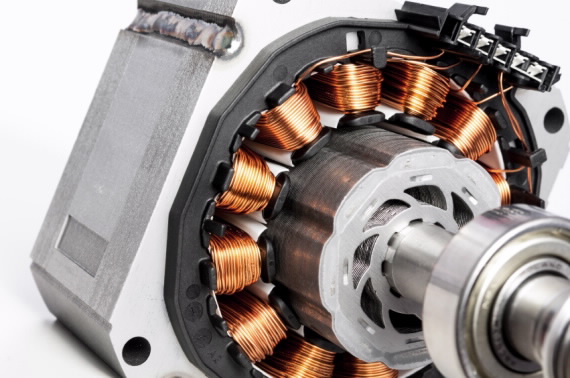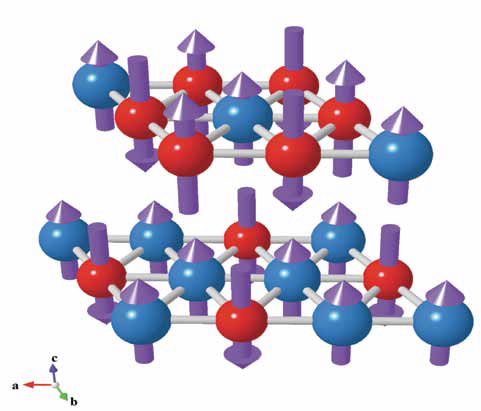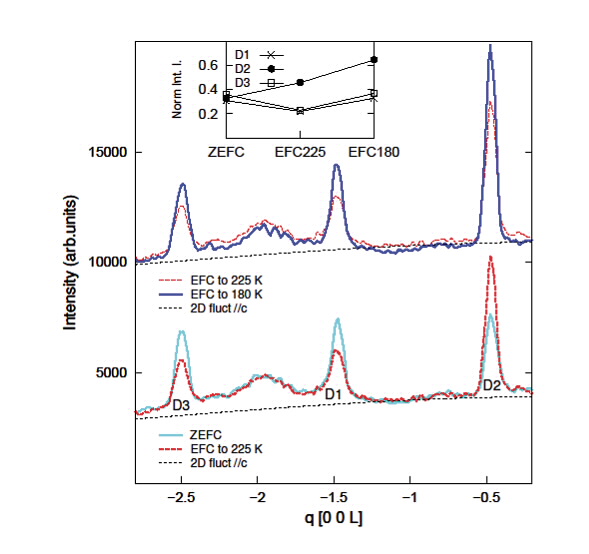Magnetic and ferroelectric materials are essential components in dozens of electronic devices and machines we use every day – but some of the mechanisms underlying their behaviour are not well understood.
 |
This study by ANSTO’s James Hester and his colleagues is aimed at better understanding these mechanisms, and subsequently developing higher-performing and more capable information technologies.
Magnets are used in components ranging from speakers, electric motors and some power plugs through to computer hard drives and automatic teller machine cards. Ferroelectric materials are not only used in some types of Random Access Memory (RAM) devices and in Radio Frequency Identification (RFID) equipment, but also for electronic toll collections on toll roads, security and access management systems and for tracking goods and animals.
Magnetic materials respond to changes in an applied magnetic field. These changes are usually ‘remembered’ after the field has been turned off. Similarly, ferroelectric materials have a spontaneous electric polarisation that can be reversed by applying an external electric field, and the new polarisation remains when the electric field is removed.
Magnetism and ferroelectricity are usually mutually exclusive, but there is a handful of materials that are known to possess both magnetic and ferroelectric properties – they are called ‘multiferroic’. Multiferroic materials have the potential to be extremely useful, for example, in the control of the magnetic components in memory-storage devices through electric manipulation, which provides faster storage and retrieval of information.
Annemieke Mulders1, Maciej Bartkowiak1, James Hester2, Ekaterina Pomjakushina3, Kazimierz Conder3 1University of New South Wales, Canberra, 2ANSTO, 3Paul Scherrer Institute, Switzerland |
Frustrated charges
Rather than arising from covalent bonding between ions, ferroelectric polarisation may instead arise from frustrated charge order, as reported for LuFe2O4. This compound is of particular interest as the magnetism originates from the same Fe ions as the ferroelectricity, suggesting that there will be strong magneto electric coupling. In addition, both ferroelectric and magnetic ordering take place at or near ambient temperature, opening the way to room-temperature applications.
LuFe2O4 forms a series of stacked Fe-containing bilayers (Fig. 1). Charge ordering occurs when the valence of each Fe ion forms a regular pattern, as indicated by the red Fe3+ and blue Fe2+ atoms in the figure. This charge order results in a net polarisation of the bilayer along both the [110] (diagonal within the layer) and [001] directions (perpendicular to the layers). The purple arrows indicate the magnetic moments of the iron ions.
 |
Figure 1: Structure of LuFe2O4 [3] in the chargeordered state showing the FeO5 bilayer and indicating small red Fe3+ and large blue Fe2+ ions, with purple magnetic moments of 5 μB and 4 μB. The oxygen atoms are omitted for the sake of clarity. |
These bilayers are stacked parallel or antiparallel along the c-axis to form a ferroelectric or antiferroelectric alignment. Long-range magnetic order is signalled by the appearance of peaks in neutron diffraction patterns, and intensity changes in these peaks give insight into the nature of the ordering.
The magnetic order in a single crystal of LuFe2O4 was therefore investigated using the Wombat high-intensity neutron diffractometer [1] at ANSTO in single-crystal mode. A change in the magnetic long-range order was observed when an applied electric field was present while cooling through the magnetic-ordering temperature [2].
Fig.2 shows that the long-range charge order that is promoted by the electricfield is stabilised by the magnetic order, as demonstrated by the increased intensity of all magnetic domains.
A possible mechanism for stabilisation of the magnetic order
It is proposed that antiferromagnetic order in the Fe bilayers facilitates the formation of long-range charge order because electron hopping between the sheets of the bilayer is assisted by the alignment of the Fe2+ and Fe3+ spins.
According to Hund’s rules for determining the distribution of electron spins between available orbitals, all the available orbitals should be populated by single electrons with the same spin before any opposite spin electrons are added. Therefore, Fe3+ has five 3d electrons with spin up, and Fe2+ has five 3d electrons with spin up and one with spin down. This latter spin down electron can jump from Fe2+ to the Fe3+ much more easily if the spin-down states of the latter are empty.
This is the case for parallel alignment of the Fe2+ and Fe3+ moments. Thus, electron hopping in the majority Fe2+ layer is arrested, because the Fe2+ and Fe3+ ions have opposite moments, while 3d electron hopping is promoted in the minority Fe2+ layer because some neighbouring Fe2+ and Fe3+ ions have parallel moments (double-exchange mechanism).
This creates a convenient mechanism to switch between ferroelectric and antiferroelectric arrangements of the bilayers. As such, the magnetism assists the ferroelectric order to align with the electric field and enhance the electric polarisation.
 |
Figure 2: Neutron intensity recorded along the (1/3 1/3 L) direction at T = 180 K, as a function of the electric-field-cooling (EFC) procedure. The magnetic state obtained after electric-field-cooling to 225 K is compared to the magnetic state obtained after zero-electric-fieldcooling (ZEFC) (bottom) and to the magnetic state obtained after electricfield- cooling to 180 K (top, shifted for clarity). The black dotted line indicates 2-dimensional magnetic order in the a-b plane, with moments along the c-axis. The inset shows the integrated intensity, normalised to the total intensity at zeroelectric- field-cooling, as a function of the electric-field-cooling sequence. |
Future perspectives
This work has led to a constructive hypothesis regarding stabilisation of ferroelectric ordering in multiferroic materials. The essential ingredients in such a scheme are a mixed-valence ion with partially filled orbitals; a structure in which these ions are distributed in hexagonal bilayers; and sufficient interaction between the ions to allow electron hopping.
Materials synthesis informed by this scheme will potentially lead to multiferroics with desirable properties, including devices that are switchable at ambient temperatures.
References
- http://www.ansto.gov.au/research/bragg_institute/facilities/instruments/wombat
- A. M. Mulders, M. Bartkowiak, J. R. Hester,E. Pomjakushina, and K. Conder, Phys.Rev. B 84, 140403(R) (2011).
- K. Momma and F. Izumi, J. Appl.Crystallogr. 41, 653 (2008).
Published: 09/08/2014


